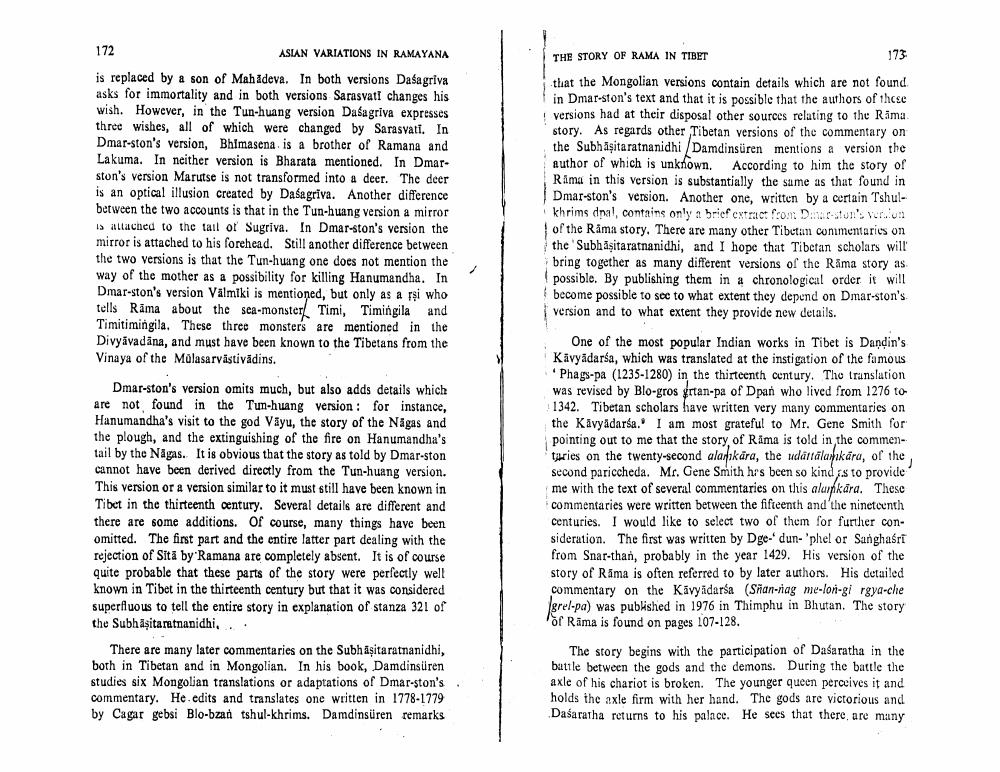Book Title: Story Of Rama In Tibet Author(s): J W De Jong Publisher: J W De Jong View full book textPage 6
________________ 172 ASIAN VARIATIONS IN RAMAYANA 173 is replaced by a son of Mahadeva. In both versions Daśagriva asks for immortality and in both versions Sarasvati changes his wish. However, in the Tun-huang version Dasagriva expresses three wishes, all of which were changed by Sarasvati. In Dmar-ston's version, Bhimasena is a brother of Ramana and Lakuma. In neither version is Bharata mentioned. In Dmar. ston's version Marutse is not transformed into a deer. The deer is an optical illusion created by Daśagriva. Another difference between the two accounts is that in the Tun-huang version a mirror Is ittlached to the tail of Sugriva. In Dmar-ston's version the mirror is attached to his forehead. Still another difference between the two versions is that the Tunhuang one does not mention the way of the mother as a possibility for killing Hanumandha. In Dmar-ston's version Valmiki is mentioned, but only as a rsi who tells Rāma about the sea-monster Timi, Timingila and Timitimingila. These three monsters are mentioned in the Divyāvadāna, and must have been known to the Tibetans from the Vinaya of the Mülasarvāstivādins. THE STORY OF RAMA IN TIBET that the Mongolian versions contain details which are not found in Dmar-ston's text and that it is possible that the authors of these versions had at their disposal other sources relating to the Rama story. As regards other Tibetan versions of the commentary on the Subhasitaratnanidhi Damdinsüren mentions a version the author of which is unknown. According to him the story of Rima in this version is substantially the same as that found in Dmar-ston's version. Another one, written by a certain Tshulkhrims dral, contains only a brief extract from D arston's veriun of the Rāma story. There are many other Tibutun commentaries on the Subh ăşitaratnanidhi, and I hope that Tibetan scholars will bring together as many different versions of the Rama story as possible. By publishing them in a chronological order it will become possible to see to what extent they depend on Dmar-ston's version and to what extent they provide new details. Dmar-ston's version omits much, but also adds details which are not found in the Tun-huang version : for instance, Hanumandha's visit to the god Vayu, the story of the Nagas and the plough, and the extinguishing of the fire on Hanumandha's tail by the Nagas. It is obvious that the story as told by Dmar-ston cannot have been derived directly from the Tun-huang version. This version or a version similar to it must still have been known in Tibet in the thirteenth century. Several details are different and there are some additions. Of course, many things have been omitted. The first part and the entire latter part dealing with the rejection of Sita by Ramana are completely absent. It is of course quite probable that these parts of the story were perfectly well known in Tibet in the thirteenth century but that it was considered superfluous to tell the entire story in explanation of stanza 321 of the Subhāşitaratnanidhi... One of the most popular Indian works in Tibet is Dandin's Kavyadarśa, which was translated at the instigation of the famous Phags-pa (1235-1280) in the thirteenth century. The translation was revised by Blo-gros grtan-pa of Dpan who lived from 1276 to 1342. Tibetan scholars have written very many commentaries on the Kävyädarśa. I am most grateful to Mr. Gene Smith for pointing out to me that the story of Rima is told in the commentaries on the twenty-second alaikära, the udattalamkāra, of the second pariccheda. Mr. Gene Smith hrs been so kinds to provide me with the text of several commentaries on this alaikära. These commentaries were written between the fifteenth and the nineteenth centuries. I would like to select two of them for further consideration. The first was written by Dge-dun- 'phel or Sanghasri from Snar-than, probably in the year 1429. His version of the story of Rama is often referred to by later authors. His detailed commentary on the Kávyādarśa (Sñan-rag me-lon-gi rgya-che Igrel-pa) was published in 1976 in Thimphu in Bhutan. The story of Rāma is found on pages 107-128. There are many later commentaries on the Subhāşitaratnanidhi, both in Tibetan and in Mongolian. In his book, Damdinsüren studies six Mongolian translations or adaptations of Dmar-ston's. commentary. He edits and translates one written in 1778-1779 by Cagar gebsi Blo-bzan tshul-khrims. Damdinsüren remarks The story begins with the participation of Dasaratha in the butile between the gods and the demons. During the battle the axle of his chariot is broken. The younger queen perceives it and holds the axle firm with her hand. The gods are victorious and Dasaratha returns to his palace. He sees that there are manyPage Navigation
1 ... 4 5 6 7 8 9 10 11
